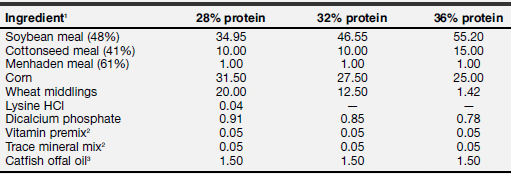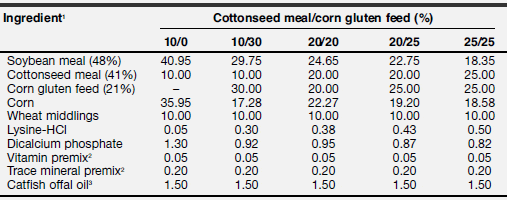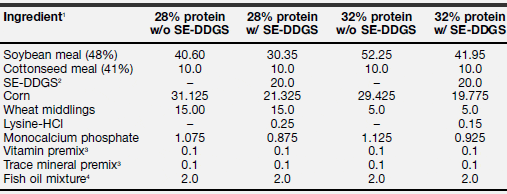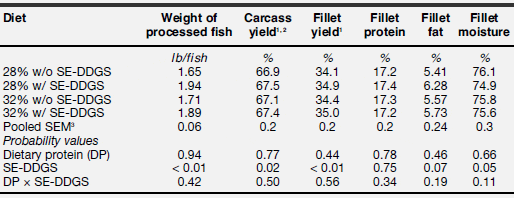Introduction
The hybrid generally performs better than either parent for several important production traits, including survival, growth, disease resistance, and carcass yield (Dunham et al. 1990; Wolters et al. 1996; Bosworth et al. 2003). Economic analyses indicate that hybrid catfish fingerling and food fish production are generally more profitable than channel catfish at moderate feed prices, even though the cost of fry and fingerlings are higher and more capital is required to produce hybrids (Ligeon et al. 2004a, b). Because of the progress of innovative breeding technologies, there is more interest in producing hybrid catfish. Currently, hybrid catfish account for about 20% of total catfish produced in the United States (personal communication, Brian Bosworth of USDA-ARS at Stoneville, Mississippi). However, relatively little is known about nutrition and feeding specific to hybrid catfish. Data presented in this report were derived from five experiments conducted in ponds to evaluate dietary protein levels, alternative feedstuffs, and feeding rates and frequencies on the performance of hybrid catfish.
Methods
All experimental diets were formulated to meet or exceed all known dietary requirements for channel catfish (NRC 2011) and manufactured as floating pellets. Fingerling hybrid catfish were stocked into experimental ponds at the National Warmwater Aquaculture Center (NWAC) in Stoneville, Mississippi. Five ponds were allotted to each treatment in a complete randomized design. Fish were fed once daily to apparent satiation or at a predetermined maximum rate (depending on specific studies) from April to October for one growing season. During the growing season, water temperature and dissolved oxygen were measured in early morning, midafternoon, and throughout the night. Routine aeration was provided when dissolved oxygen levels decreased to 4 ppm. Total ammonia-nitrogen, nitrite-nitrogen, and pH were measured biweekly during the growing season. Water quality was maintained in ranges considered adequate for optimum fish performance (Tucker and Robinson 1990). Dead fish were removed from ponds, weighed, and recorded for correction of feed conversion ratio (FCR) at the end of the study.
At the end of each diet evaluation study, 30 fish from each pond were selected to determine processed yield. Fillets (one fillet per fish, 10 fish per pond) were stored at -4°F for proximate analyses. After sampling, all fish from each pond were harvested, counted, and weighed. Data collected included total feed fed, net yield, weight gain, feed conversion ratio, survival, dressed yield, and fillet proximate composition. Protein, fat, and moisture were analyzed according to standard methods (AOAC 2000). All data were subjected to analysis of variance and the Fisher’s protected leastsignificant- difference procedure (Steel et al. 1997) using Statistical Analysis System version 8.0 software (SAS Institute, Inc., Cary, North Carolina).
Table 1. Ingredient Composition of Experimental Diets (Percentage, as-fed) used in Experiment 1.

2Meet requirements for channel catfish.
3Sprayed on the finished pellets.
Table 2. Ingredient Composition of Experimental Diets (Percentage, as-fed) used in Experiment 2.

2Meet requirements for channel catfish.
3Sprayed on the finished pellets.
Table 3. Ingredient Composition of Experimental Diets (Percentage, as-fed) used in Experiment 3.

2Solvent-extract distillers dried grains with solubles.
3Meet requirements for channel catfish.
4Menhaden oil:catfish oil (1:1); sprayed on finished diets.
Experiment 1
Three diets containing 28%, 32%, or 36% protein (Table 1) were evaluated to determine optimum dietary protein levels for hybrid catfish. Diets were manufactured at the Delta Western Research Center in Indianola, Mississippi. Fingerling hybrid catfish averaging 103 pounds per 1,000 were stocked in 0.1-acre ponds at 7,000 fish per acre and fed once daily to apparent satiation for 151 days.
Experiment 2
Corn gluten feed or a combination of corn gluten feed and cottonseed meal was evaluated as partial replacements for soybean meal and corn in hybrid catfish diets. Five 28%-protein diets were included (Table 2). The diets were manufactured at the Delta Western Research Center. Fingerling hybrid catfish averaging 99 pounds per 1,000 were stocked in 0.1-acre ponds at 6,000 fish per acre and fed once daily to satiation for 179 days.
Experiment 3
This experiment examined the use of solventextracted distillers’ grains with solubles (SE-DDGS) in hybrid catfish diets. Four diets containing 28% or 32% protein with or without SE-DDGS were included (Table 3). The diets were manufactured at Fish Belt Feed Mill in Moorhead, Mississippi. Fingerling hybrid catfish averaging 103 pounds per 1,000 were stocked in 0.1-acre ponds at 6,000 fish per acre and fed once daily to satiation for 172 days.
Experiment 4
Experiment 4 compared feeding once versus twice daily on production characteristics of pond-raised hybrid catfish. Fingerling hybrid catfish averaging 143 pounds per 1,000 were stocked in 1-acre ponds at 5,000 fish per acre and fed once or twice daily to satiation for 165 days. A commercial 28%-protein diet was used.
Experiment 5
Experiment 5 was conducted to examine effects of feeding to satiation versus feeding at various daily feeding rates on production characteristics and size distribution of hybrid catfish in production ponds. Fingerling hybrid catfish averaging 99 pounds per 1,000 were stocked in 0.1-acre ponds at 6,000 fish per acre and fed once daily to satiation or no more than 100, 120, and 150 pounds for 195 days. A commercial 28%-protein diet was used. Simple regression analysis was conducted for weight gain, net yield, and FCR against total amount of diet fed.
Results and Discussion
Optimum Dietary Protein Levels
There is a large body of evidence that a 28%- protein diet provides essentially the same growth and feed efficiency as higher protein diets for pond-raised channel catfish (Li and Lovell 1992; Robinson and Li 1997; Robinson et al. 2004). However, blue catfish appear to require 32% protein for optimum growth (Li et al. 2008). Commercial hybrid catfish raised from advanced fingerlings to market size have been typically fed the same diet as channel catfish, either 28% or 32% protein. Results from Experiment 1 show that hybrid catfish have a protein requirement similar to that of channel catfish. There were no significant differences in total feed fed, net yield, weight gain, feed conversion ratio (FCR), or survival among fish fed diets containing 28%, 32%, or 36% protein (Table 4). There were also no significant differences in carcass yield, fillet protein, and moisture among fish fed various diets (Table 5). However, fish fed the 36%- protein diet had a higher fillet yield and lower fillet fat than fish fed the 28%-protein diet. Fish fed the 32%-protein diet had intermediate fillet yield, which was not significantly different from that of fish fed the 28%- or 36%- protein diets. Fish fed the 28%- and 32%-protein diets had similar fillet fat levels. These results agree well with data reported for channel catfish (Li and Lovell 1992; Robinson et al. 2004), which demonstrated that 28% protein is sufficient for optimum growth and feed efficiency. As with channel catfish, the body fat level in hybrid catfish is generally reduced and processed yield is improved as dietary protein levels increase and digestible energy to protein (DE:P) ratios decrease. This is because as dietary protein increases, the dietary DE:P ratio becomes optimized. However, using high-protein diets to reduce body fattiness and improve processed yield may not be economical for the catfish producer.
Table 4. Mean Production Characteristics of Channel Catfish fed 28%-, 32%-, or 36%-protein Diets in Experiment 1.1

2Mean initial weight was 146 pounds per 1,000 fish.
3Standard error for mean.
Table 5. Mean Processing Characteristics and Fillet Composition of Hybrid Catfish fed 28%-, 32%-, or 36%-protein Diets in Experiment 1.1

2Means represent average values of five ponds per treatment with 30 fish per pond.
3Carcass yield is a percentage of the carcass (without head and viscera) weight relative to whole fish weight.
4Standard error for mean.
Table 6. Mean Production Characteristics of Hybrid Catfish fed 28%-protein Diets Containing Various Levels of Cottonseed Meal (CSM) and Corn Gluten Feed (CGF) in Experiment 2.1

2Mean initial weight was 99 pounds per 1,000 fish.
3Standard error for mean.
Table 7. Mean Processing Characteristics and Proximate Composition of Hybrid Catfish fed 28%-protein Diets Containing Various Levels of Cottonseed meal (CSM) and Corn Gluten Feed (CGF) in Experiment 2.1

2Means represent average values of five ponds per treatment with 30 fish per pond.
3Carcass yield is a percentage of the carcass (without head and viscera) weight relative to whole fish weight.
4Standard error for mean.
Use of CGF and CSM to Partially Replace Soybean Meal and Corn
Soybean meal has been the main protein source, and corn has been the primary energy source used in catfish diets. However, prices for these traditional dietary ingredients have increased dramatically in recent years. Thus, there has been considerable interest in finding less expensive, alternative feedstuffs for use in catfish diets. Corn gluten feed — a by-product of corn milling — and cottonseed meal are currently competitively priced compared with soybean meal and corn. Use of a combination of these two ingredients would reduce feed cost for catfish production. Results from Experiment 2 showed that corn gluten feed at levels up to 30% of the diet and that a combination of corn gluten feed and cottonseed meal up to 25% each did not affect feed consumption, net yield, weight gain, FCR, survival, or fillet proximate nutrient composition (Tables 6 and 7). However, a combination of corn gluten feed and cottonseed meal at 20% or more each reduced carcass yield of the fish. Similar results have been reported previously for channel catfish (Li et al. 2011). It is not clear why processed yield is reduced in catfish fed diets containing relatively high levels of corn gluten feed and cottonseed meal. Possible contributing factors include lower digestible protein, higher fiber concentrations, and lower and imbalanced essential amino acids in these plant feedstuffs.
Table 8. Mean Production Characteristics of Hybrid Catfish fed 28%- or 32%-protein Diets with or without Solvent-extracted Distillers Dried Grains with Solubles (SE-DDGS) in Experiment 3.

2Standard error for mean.
Table 9. Mean Processing Characteristics and Fillet Composition of Hybrid Catfish fed 28%- or 32%-protein Diets with or without Solvent-extracted Distillers Dried Grains with Solubles (SE-DDGS) in Experiment 3.

2Carcass yield is a percentage of the carcass (without head and viscera) weight relative to whole fish weight.
3Standard error for mean.
Table 10. Mean Production Characteristics of Hybrid Catfish fed a Commercial 28%-protein Diet Once or Twice Daily in Experiment 4.1

2Mean initial weight was 143 pounds per 1,000 fish.
3Estimated based on 500-fish sample per pond.
4Standard error for mean.
Table 11. Mean Production Characteristics of Hybrid Catfish fed a 28%-protein Diet Once Daily at Rates of ?100, ?120, or ?150 Pounds per acre, or Once Daily to Satiation in Experiment 5.1

2Mean initial weight was 103 pounds per 1,000 fish.
3Standard error for mean.
Use of SE-DDGS with Solubles to Partially Replace Soybean Meal
Distillers dried grains with solubles (DDGS) from corn is a by-product of ethanol production. It is relatively high in protein (27%) and highly palatable to channel catfish. With the rapid expansion of ethanol production in the United States, the price for DDGS has become more competitive compared with soybean meal and other plant protein sources. Solventextracted distillers dried grains with solubles (SE-DDGS) is a local product that is available for use in catfish feeds. The SEDDGS contains about 5% oil compared with 10% oil in the original by-product. The lower fat product is a better fit for catfish feeds because high dietary fat may result in an increase in tissue fat and a decrease in processed yield.
There were no significant differences in total feed fed, net yield, weight gain, or survival among dietary treatments in Experiment 3 (Table 8). Regardless of dietary protein levels, fish fed the diets containing 20% SE-DDGS had slightly, but significantly better feed efficiency compared with that of the control (1.50 vs. 1.55 FCR). The improvement in FCR may not have practical implications because the difference was quite small. However, improvements in FCR have been reported previously for channel catfish fed diets containing regular DDGS (Robinson and Li 2008; Li et al. 2010, 2011). Hybrid catfish fed the SE-DDGS diets had higher carcass yield and fillet yield than fish fed the control diets (Table 9). But fish selected for processing were also significantly larger for the SE-DDGS diets even though there were no significant differences in overall final fish weight. Analysis of variance using weight of fish selected for processing as a covariant showed no significant differences in carcass and fillet yield. Data also support findings from previous studies that a nutritionally balanced, 28%-protein diet is sufficient for optimum growth and feed efficiency for hybrid catfish grown from fingerlings to market size.
Feeding Once versus Twice Daily
During food fish production, catfish are typically fed once daily, and research with channel catfish has shown that feeding once daily is satisfactory (Robinson et al. 1995; Li et al. 2005). There were anecdotal reports that feeding twice daily increased feed consumption and growth rate of the hybrids and thus enabled the fish to reach market size in a shorter period of time because they are aggressive eaters. Results from Experiment 4 showed that hybrids fed twice daily to apparent satiation were given more feed than fish fed once daily (Table 10), but the higher feed input did not result in higher net yield and weight gain. As a result, FCR increased likely because of overfeeding and feed wastage.
Satiation Versus Restricted Feeding
Feeding rate is an important consideration under normal circumstances but especially so when feed prices are high. Catfish should be fed to near satiation without feed wastage and without adversely affecting water quality. However, feeding to satiation is highly subjective since it is difficult to determine when the fish are satiated. Thus, it is easy to overfeed, which results in wasted feed that increases production cost and may have deleterious effects on water quality. There were no significant differences in net yield and weight gain among fish fed daily at various rates in Experiment 5 by analysis of variance (Table 11). Fish fed no more than 100 and 120 pounds per acre per day had significantly lower FCR than fish fed daily to satiation. Simple regression analysis indicated that weight gain, net yield, and FCR increased linearly as the total amount of feed fed increased. These results were similar to data reported for channel catfish (Robinson and Li 1999; Robinson et al. 2004). Results also support findings by Green and Rawles (2010), who reported that hybrid catfish converted feed more efficiently when fed a restricted ration.
Conclusions
- Protein requirements of hybrid catfish do not differ from those of channel catfish. Hybrids appear to have the same response as channel catfish to various dietary formulations, feeding rates, and frequencies.
- A nutritionally complete, 28%-protein diet containing alternative feedstuffs such as cottonseed meal and corn gluten feed or DDGS is sufficient for optimum growth and feed efficiency of hybrid catfish. However, use of high levels of alternative feedstuffs may reduce processed yield.
- Feeding once daily to near satiation, but limiting feed to about 120 pounds per acre per day, appears to provide satisfactory growth and feed efficiency when hybrid catfish are stocked at about 6,000 fish per acre and grown from large fingerlings to market size (about 1.5 pound).
May 2013




